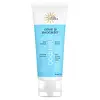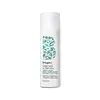What's inside
What's inside
 Key Ingredients
Key Ingredients

No key ingredients
 Benefits
Benefits

 Concerns
Concerns

 Ingredients Side-by-side
Ingredients Side-by-side

Water
Skin ConditioningSodium Cocoyl Isethionate
CleansingCocamidopropyl Betaine
CleansingSodium Methyl Cocoyl Taurate
CleansingCocamidopropyl Hydroxysultaine
CleansingGlycerin
HumectantArgania Spinosa Kernel Oil
EmollientButyrospermum Parkii Butter
Skin ConditioningCocos Nucifera Oil
MaskingAloe Barbadensis Leaf Juice
Skin ConditioningHydrolyzed Silk
HumectantPersea Gratissima Oil
Skin ConditioningOlea Europaea Fruit Oil
MaskingGlyceryl Caprylate
EmollientGlyceryl Undecylenate
EmollientGlycol Distearate
EmollientPotassium Sorbate
PreservativeHydroxyethylcellulose
Emulsion StabilisingCitric Acid
BufferingParfum
MaskingWater, Sodium Cocoyl Isethionate, Cocamidopropyl Betaine, Sodium Methyl Cocoyl Taurate, Cocamidopropyl Hydroxysultaine, Glycerin, Argania Spinosa Kernel Oil, Butyrospermum Parkii Butter, Cocos Nucifera Oil, Aloe Barbadensis Leaf Juice, Hydrolyzed Silk, Persea Gratissima Oil, Olea Europaea Fruit Oil, Glyceryl Caprylate, Glyceryl Undecylenate, Glycol Distearate, Potassium Sorbate, Hydroxyethylcellulose, Citric Acid, Parfum
Water
Skin ConditioningSodium Cocoyl Isethionate
CleansingLauramidopropyl Betaine
CleansingGlycerin
HumectantSodium C14-16 Olefin Sulfonate
CleansingCocamidopropyl Hydroxysultaine
CleansingCoffea Arabica Seed Oil
MaskingCopper Tripeptide-34
Skin ConditioningPanax Ginseng Root Extract
EmollientBiotin
AntiseborrhoeicCoconut Acid
CleansingLeuconostoc/Radish Root Ferment Filtrate
AntimicrobialSodium Methyl Cocoyl Taurate
CleansingSodium Isethionate
CleansingCitric Acid
BufferingAloe Barbadensis Leaf Juice
Skin ConditioningCaffeine
Skin ConditioningPropanediol
SolventLindera Strychnifolia Root Extract
Skin ConditioningTocopheryl Acetate
AntioxidantUbiquinone
AntioxidantGlycine
BufferingLarix Europaea Wood Extract
HumectantSodium Metabisulfite
AntioxidantCamellia Sinensis Leaf Extract
AntimicrobialZinc Chloride
AntimicrobialSodium Hydroxide
BufferingParfum
MaskingCaprylhydroxamic Acid
Benzyl Alcohol
PerfumingWater, Sodium Cocoyl Isethionate, Lauramidopropyl Betaine, Glycerin, Sodium C14-16 Olefin Sulfonate, Cocamidopropyl Hydroxysultaine, Coffea Arabica Seed Oil, Copper Tripeptide-34, Panax Ginseng Root Extract, Biotin, Coconut Acid, Leuconostoc/Radish Root Ferment Filtrate, Sodium Methyl Cocoyl Taurate, Sodium Isethionate, Citric Acid, Aloe Barbadensis Leaf Juice, Caffeine, Propanediol, Lindera Strychnifolia Root Extract, Tocopheryl Acetate, Ubiquinone, Glycine, Larix Europaea Wood Extract, Sodium Metabisulfite, Camellia Sinensis Leaf Extract, Zinc Chloride, Sodium Hydroxide, Parfum, Caprylhydroxamic Acid, Benzyl Alcohol
Ingredients Explained
These ingredients are found in both products.
Ingredients higher up in an ingredient list are typically present in a larger amount.
Aloe Barbadensis Leaf Juice comes from leaves of the aloe plant. Aloe Barbadensis Leaf Juice is best known for helping to soothe sunburns. It is also anti-inflammatory, moisturizing, antiseptic, and can help heal wounds.
Aloe is packed with good stuff including Vitamins A, C, and E. These vitamins are antioxidants, which help fight free-radicals and the damage they may cause. Free-radicals are molecules that may damage your skin cells, such as pollution.
Aloe Barbadensis Leaf Juice also contains sugars. These sugars come in the form of monosaccharides and polysaccharides, folic acid, and choline. These sugars are able to help bind moisture to skin.
It also contains minerals such as calcium, 12 anthraquinones, fatty acids, amino acids, and Vitamin B12.
Learn more about Aloe Barbadensis Leaf JuiceCitric Acid is an alpha hydroxy acid (AHA) naturally found in citrus fruits like oranges, lemons, and limes.
Like other AHAs, citric acid can exfoliate skin by breaking down the bonds that hold dead skin cells together. This helps reveal smoother and brighter skin underneath.
However, this exfoliating effect only happens at high concentrations (20%) which can be hard to find in cosmetic products.
Due to this, citric acid is usually included in small amounts as a pH adjuster. This helps keep products slightly more acidic and compatible with skin's natural pH.
In skincare formulas, citric acid can:
While it can provide some skin benefits, research shows lactic acid and glycolic acid are generally more effective and less irritating exfoliants.
Most citric acid used in skincare today is made by fermenting sugars (usually from molasses). This synthetic version is identical to the natural citrus form but easier to stabilize and use in formulations.
Read more about some other popular AHA's here:
Learn more about Citric AcidCocamidopropyl Hydroxysultaine is a synthetic cleansing agent, though it is derived from coconut oil.
It is used to enhance the texture of products by boosting lather and thickening the texture. As a cleanser, Cocamidopropyl Hydroxysultaine is mild.
Glycerin is already naturally found in your skin. It helps moisturize and protect your skin.
A study from 2016 found glycerin to be more effective as a humectant than AHAs and hyaluronic acid.
As a humectant, it helps the skin stay hydrated by pulling moisture to your skin. The low molecular weight of glycerin allows it to pull moisture into the deeper layers of your skin.
Hydrated skin improves your skin barrier; Your skin barrier helps protect against irritants and bacteria.
Glycerin has also been found to have antimicrobial and antiviral properties. Due to these properties, glycerin is often used in wound and burn treatments.
In cosmetics, glycerin is usually derived from plants such as soybean or palm. However, it can also be sourced from animals, such as tallow or animal fat.
This ingredient is organic, colorless, odorless, and non-toxic.
Glycerin is the name for this ingredient in American English. British English uses Glycerol/Glycerine.
Learn more about GlycerinParfum is a catch-all term for an ingredient or more that is used to give a scent to products.
Also called "fragrance", this ingredient can be a blend of hundreds of chemicals or plant oils. This means every product with "fragrance" or "parfum" in the ingredients list is a different mixture.
For instance, Habanolide is a proprietary trade name for a specific aroma chemical. When used as a fragrance ingredient in cosmetics, most aroma chemicals fall under the broad labeling category of “FRAGRANCE” or “PARFUM” according to EU and US regulations.
The term 'parfum' or 'fragrance' is not regulated in many countries. In many cases, it is up to the brand to define this term.
For instance, many brands choose to label themselves as "fragrance-free" because they are not using synthetic fragrances. However, their products may still contain ingredients such as essential oils that are considered a fragrance by INCI standards.
One example is Calendula flower extract. Calendula is an essential oil that still imparts a scent or 'fragrance'.
Depending on the blend, the ingredients in the mixture can cause allergies and sensitivities on the skin. Some ingredients that are known EU allergens include linalool and citronellol.
Parfum can also be used to mask or cover an unpleasant scent.
The bottom line is: not all fragrances/parfum/ingredients are created equally. If you are worried about fragrances, we recommend taking a closer look at an ingredient. And of course, we always recommend speaking with a professional.
Learn more about ParfumSodium cocoyl isethionate is a natural ingredient from coconut oil. It is an ultra gentle cleanser that gives a nice foam without drying the skin or impacting the skin barrier.
The amount of foam created depends on the amount of sodium cocoyl isethionate used in the product.
This ingredient also helps improve the spreadability of a product.
Learn more about Sodium Cocoyl IsethionateThis gentle cleansing and foaming ingredient is known for leaving a smooth feeling in skin and hair. It is made using coconut oil.
According to the manufacturer, it is soluble in water and has resistance to hard water, acid, and alkali.
Due to its coconut base, it may not be Malassezia folliculitis safe.
Learn more about Sodium Methyl Cocoyl TaurateWater. It's the most common cosmetic ingredient of all. You'll usually see it at the top of ingredient lists, meaning that it makes up the largest part of the product.
So why is it so popular? Water most often acts as a solvent - this means that it helps dissolve other ingredients into the formulation.
You'll also recognize water as that liquid we all need to stay alive. If you see this, drink a glass of water. Stay hydrated!
Learn more about Water